Quick links
About this guide
The general capabilities are embedded within specific learning activities and can be identified with the following icons:
The general capabilities are embedded within specific learning activities and can be identified with the following icons:
Part teenage fever-dream, part dystopian nightmare, Hans and Gret warps reality to epically reinvent a classic fairytale and turn it into a tripped-out psychological thriller pulsing with danger, betrayal, and dread.
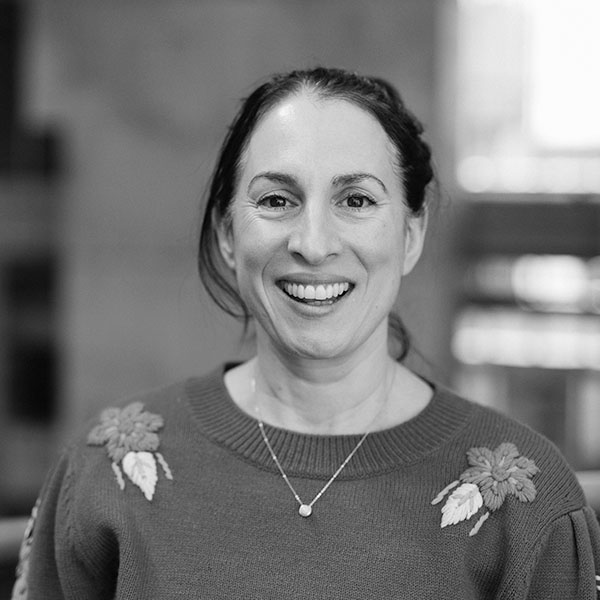
Writer
Lally Katz is one of Australia’s most original and in-demand writers. She has written over 50 plays, most of which have been professionally produced. Lally’s work has been described “as if The Simpsons was written by Tennessee Williams” (Sydney Morning Herald 2016). Her work has been produced widely across Australia and in London, Dublin, New York City, Mexico City and Delhi. Lally’s libretto for Opera Australia’s production of The Rabbits won the 2016 AWGIE Award for Best Music Theatre Script and a Helpmann Award for Best New Work.

Director
Clare is an award-winning director and theatre-maker. She was the Artistic Director of Black Swan State Theatre Company from 2016 to 2022. Previously, Clare was Artistic Director at St Martins collaborating with children and teenagers. Her work has been presented by Malthouse Theatre, Melbourne Theatre Company, State Theatre Company South Australia, Sydney Theatre Company, Edinburgh Festival and Adelaide Festival among many others. Clare is a graduate of Directing at the Victorian College of the Arts and is a recipient of the Sidney Myer Performing Arts Award.

Concept
Under Rose’s leadership as Artistic Director, Windmill creates and presents work inspired by the vibrancy, sophistication and inventiveness of young people and the exhilarating challenges they pose to creating theatre of relevance in this modern time. Rose is a multi-Helpmann Award winning director, her productions regularly visit leading stages and festivals around Australia and the world, including the Sydney Opera House, Hong Kong’s Arts and Leisure Centre and New York’s New Victory Theatre. Her directing credits for Windmill include Rumpelstiltskin, Pinocchio, The Wizard of Oz, Fugitive, School Dance, Big Bad Wolf and Girl Asleep. In 2015, she directed her first feature film Girl Asleep with Windmill Theatre Co, and in 2017 she was awarded the prestigious Australia Council Theatre Award.

Designer
An award-winning designer for theatre, film and television, Jonathon has designed for companies including: Sydney Theatre Company, Melbourne Theatre Company, Queensland Theatre, State Theatre Company of South Australia (STCSA), Belvoir Theatre, LaBoite, Bell Shakespeare, isthisyours?, Aphids, Arena Theatre Company, Polyglot, The Real TV Project, Polytoxic, Men of Steel, Lemony S Puppet Theatre, Terrapin Puppet Theatre, Vitalstatistix, Barking Gecko, The Border Project, Dead Puppet Society, The Last Great Hunt, Restless Dance Theatre, The Escapists and Sandpit. Jonathon was festival designer for the Out of the Box Festival and Brisbane Festival’s Arcadia.

Lighting Designer
Richard Vabre is a freelance lighting designer who has lit productions for MTC, STC, Malthouse Theatre, Belvoir Street, Black Swan State Theatre Company, Back To Back Theatre, Victorian Opera, Circus Oz, Windmill Theatre, Arena Theatre Company, NICA, Barking Gecko, The Darwin Festival, Stuck Pig’s Squealing, Chambermade, Rawcus, Red Stitch, Polyglot, Melbourne Worker’s Theatre, Aphids and many many productions at La Mama Awards: Richard has won 5 Green Room Awards including the Association’s John Truscott Prize for Excellence in Design (2004). He has also been nominated for 10 other Green Room Awards.

Composer, Sound Designer and Sound System Designer
Brendan Woithe gained his post-graduate Masters in sound from AFTRS, and has never stopped studying music. His work often takes on unique acoustic instrumental connections with the projects, and moulds them into contemporary compositions.
Recent work includes composing the score and sound for the Shanghai Corporate Pavilion for the World Expo, a sound installation the AT&T TriBeCa Film Festival, and sound design for the opera Clusters of Light in Arab Emirates. He’s worked extensively with Australian Dance Theatre and has worked broadly across film, television and the stage.

Dramaturg
Sam is a Creative Director of Sandpit, a company that create immersive, and interactive theatre and personal experiences. Sam was the Artistic Director of The Border Project from 2002-2012, directing or co-directing all of their work during that time.
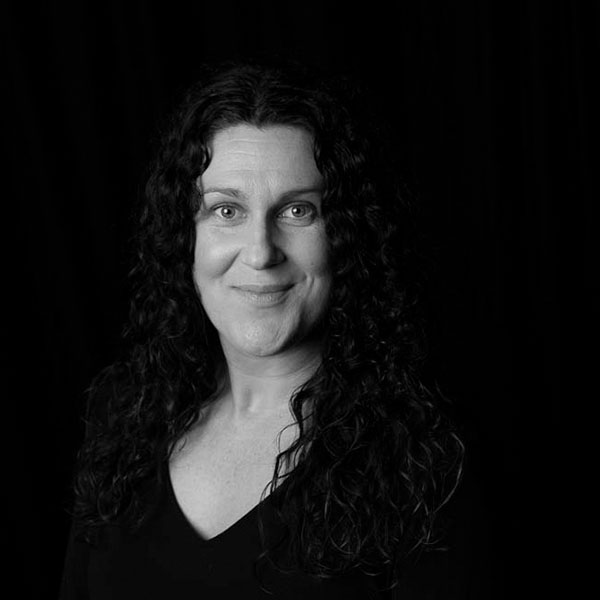
Movement Consultant
Larissa McGowan graduated from the Victorian College of Arts and joined Australian Dance Theatre in 2000, touring extensively nationally and internationally with the company for eleven years. In 2008 McGowan was named the Australian Dance Theatre’s Associate Choreographer. Following her 2003 Green Room Award for Best Female Dancer, McGowan won multiple prizes in 2004 at the Helpmann Awards and the Australian Dance Awards.
Larissa has worked with Sydney Dance Company, Link Dance Company, Vitalstatistix, Adelaide Cabaret Festival, Brisbane Powerhouse, State Theatre Company South Australia, Restless Dance Theatre, Tasdance and Co:3 among many others. Her work has been presented by the likes of Adelaide Festival, Dance Massive and Dublin Dance Festival.
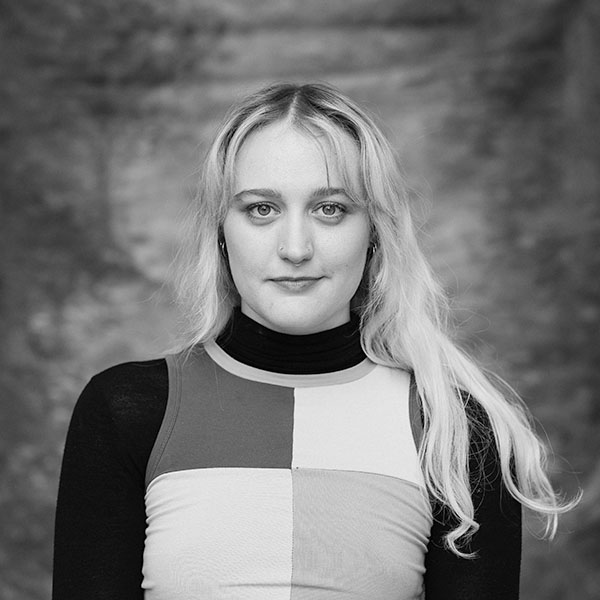
Actor
After graduating from Adelaide College of the Arts, Temeka has forged a career in South Australia’s theatre scene and theatremaker. She has worked extensively with Patch Theatre, touring nationally with the company, and is Associate Artistic Director of The Paperboats. Temeka is a yoga instructor, life model, artist and all round creative.

Actor
A graduate of Adelaide College of the Arts, Dylan has worked with State Theatre Company South Australia, Windmill Theatre Company and Sydney Theatre Company. In 2019 he toured internationally with The Secret River.

Actor
Jo Stone is an actor, movement consultant, voice artist and director based in Adelaide, South Australia. In 2002, she formed the groundbreaking company Stone/Castro with theatremaker Paulo Castro. Stone/Castro’s work has been presented widely, with seasons in Adelaide, Lisbon, Melbourne and Canberra among many others.
Jo has worked with Adelaide Festival, DanceNorth, State Theatre Company South Australia, LadyKillers, APHIDS, Brink Productions, Portuguese National Theatre, State Opera South Australia and Windmill Theatre Company among many others. She is currently part of the teaching faculty at AC Arts.

Actor
Gareth Davies is an actor and playwright based in Sydney. He is a member of the Black Lung Theatre
Gareth has worked with Melbourne Theatre Company, Malthouse Theatre Company, Belvoir, Bell Shakespeare, Griffin Theatre Company, Redline Productions, Queensland Theatre, Darwin Festival and many others. His film and TV credits include The Daughter (Screen NSW/Fate Films), The Letdown (Giant Dwarf/ABC), Hunters (Universal Cable/Valhalla) and the upcoming Peter Rabbit (Animal Logic).

Actor
A graduate of Flinders Drama Centre, James Smith has worked extensively as an actor and theatremaker across South Australia. James has worked with State Theatre Company South Australia, Windmill Theatre Company, Theatre Republic and Brink Productions among many others. Throughout 2021, he toured nationally with the Australian tour of Girl from the North Country.

Actor
Antoine is an actor, theatre-maker, composer and sound designer for stage and screen. Antoine has worked with State Theatre Company South Australia, Windmill Theatre Company, Tiny Bricks, Brink Productions, Audioplay and many others. He has worked as a composer and sound designer for Windmill Theatre Company, Di and Viv and Rose (Rumpus 2022), Coldhands (Rumpus 2022), The Wolves (Rumpus 2021).

Actor
Emily graduated from QUT with Distinction in a Bachelor of Fine Arts (Acting) in 2021. Highlights from QUT include Gloria, Twelfth Night and The Laramie Project. In 2022 Emily made her professional theatre debut with debase productions in the premiere of Death in a Statesman and worked with La Boite Theatre as a cover for An Ideal Husband. She first worked with Windmill in 2015 on their critically acclaimed film Girl Asleep and is thrilled to be back with them again for the premiere season of Hans and Gret.
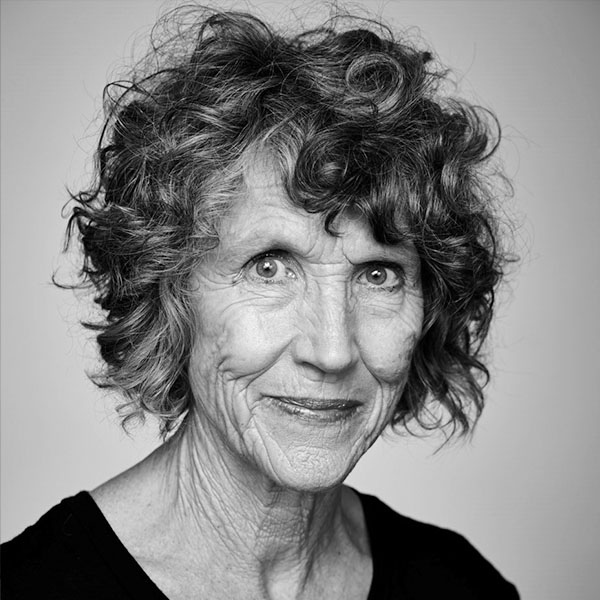
Actor
Chrissie is an actor, theatremaker and arts advocate based in South Australia. She has worked with State Theatre Company South Australia, Flying Penguin Productions, Windmill Theatre Company, Foul Play, Human Movement and ActNow Theatre among many others. She has performed all over Australia and internationally in Edinburgh.
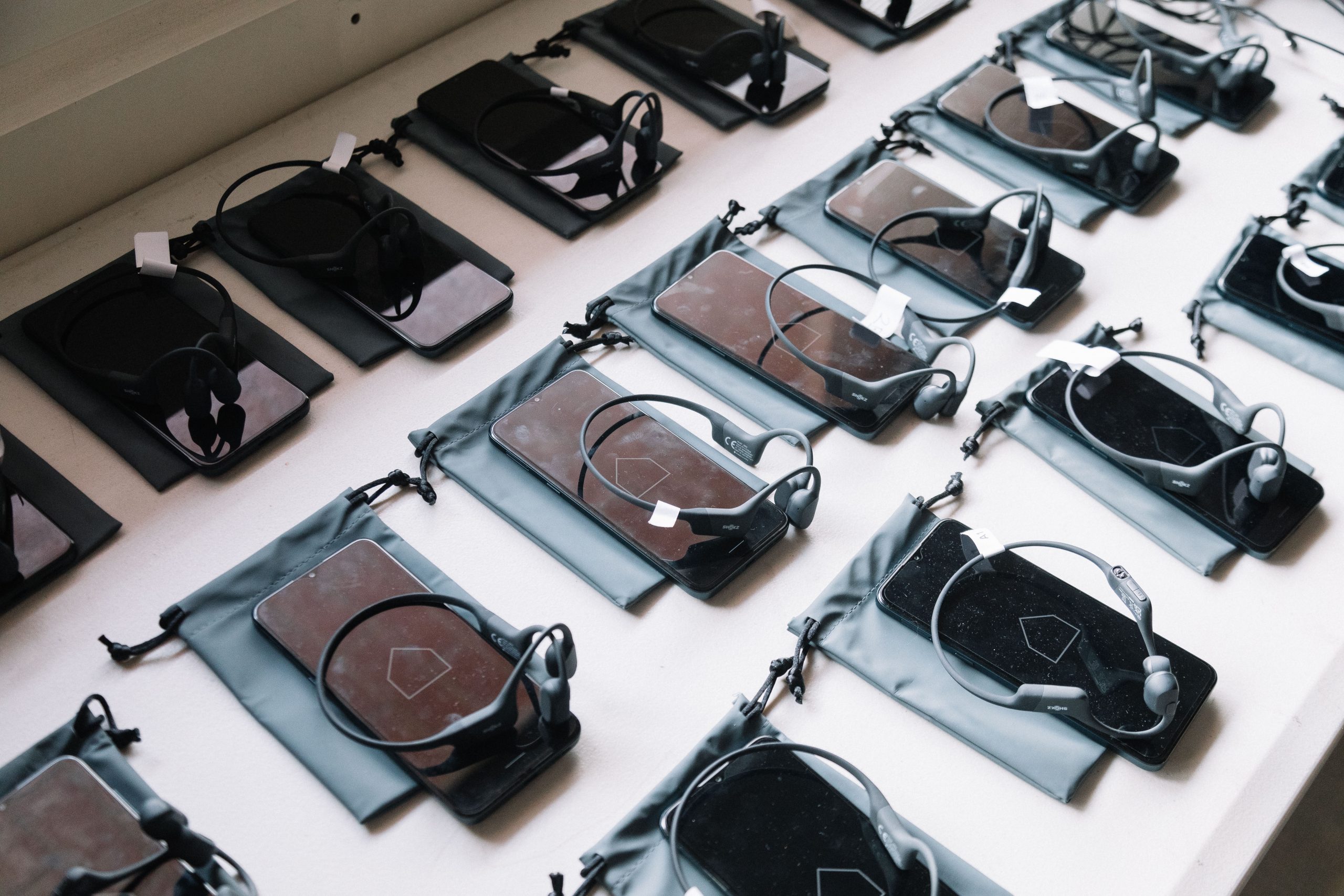

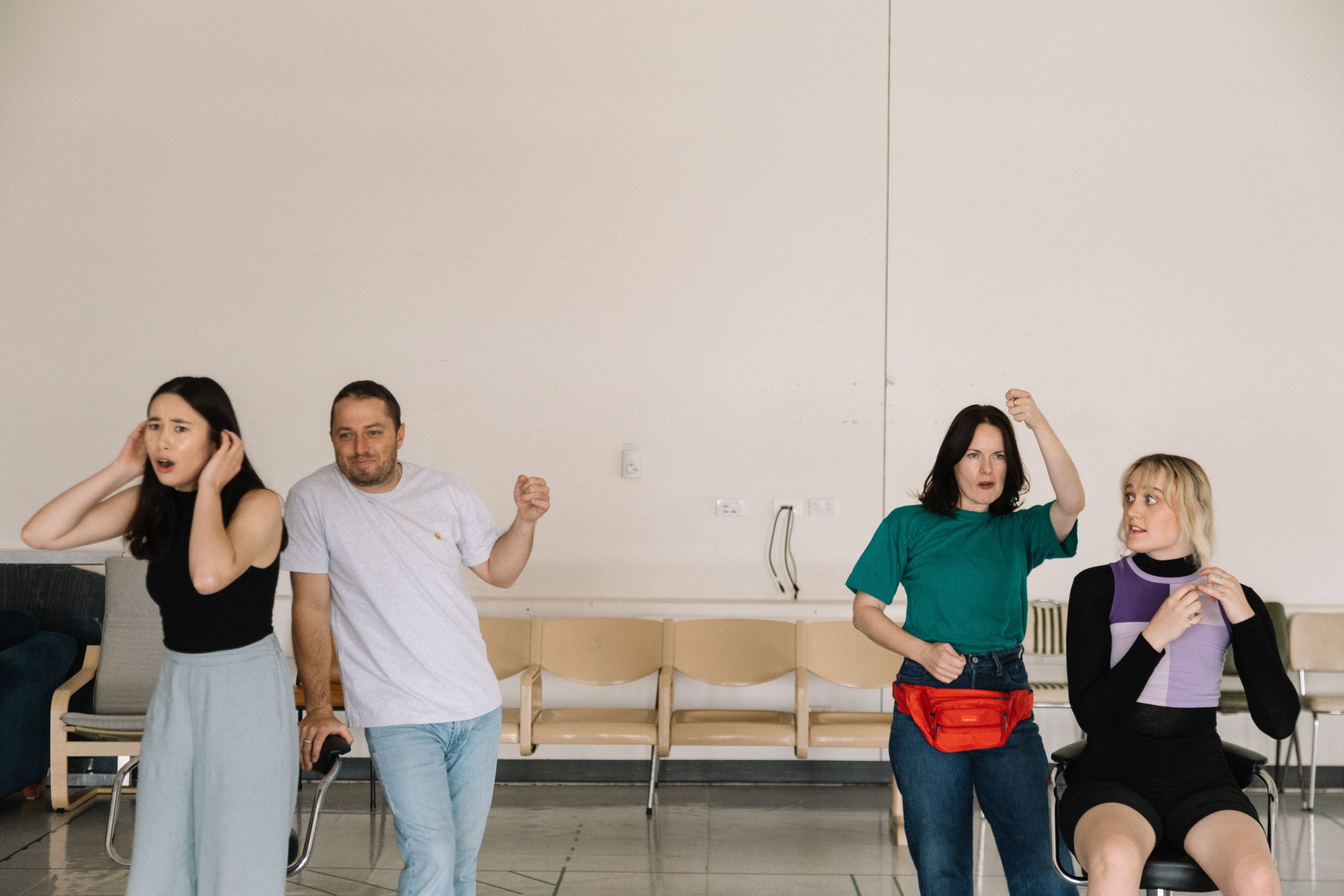
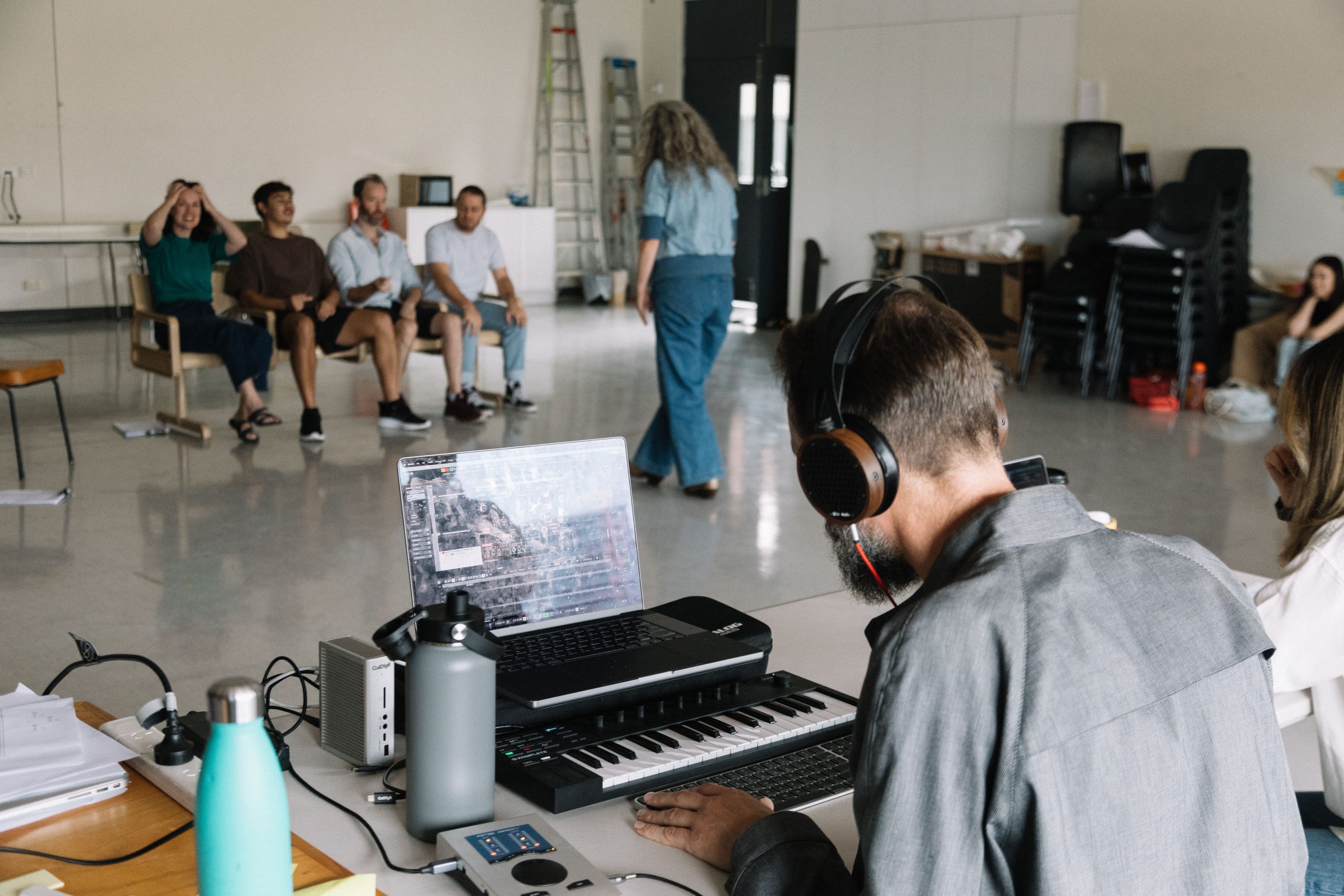

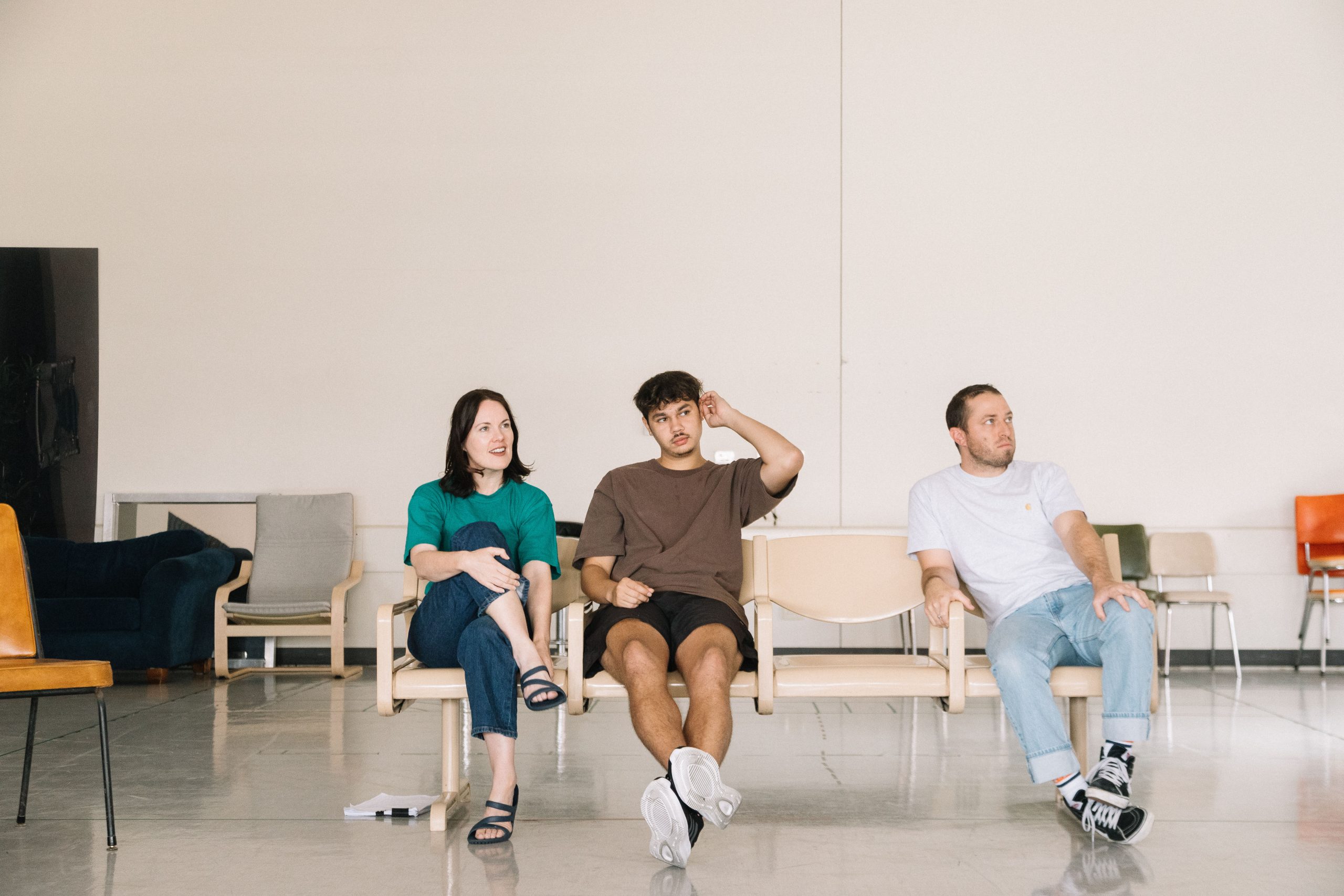
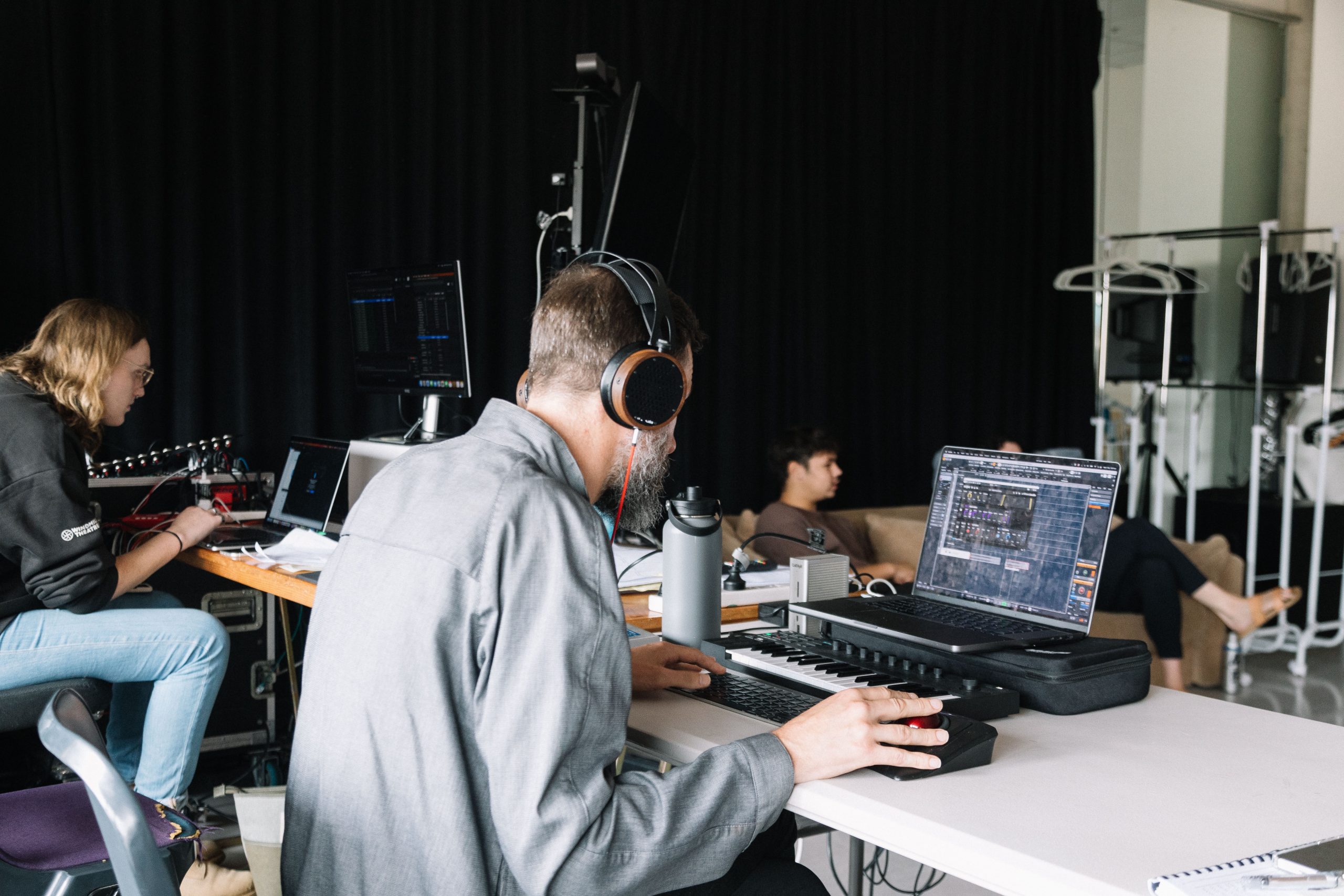
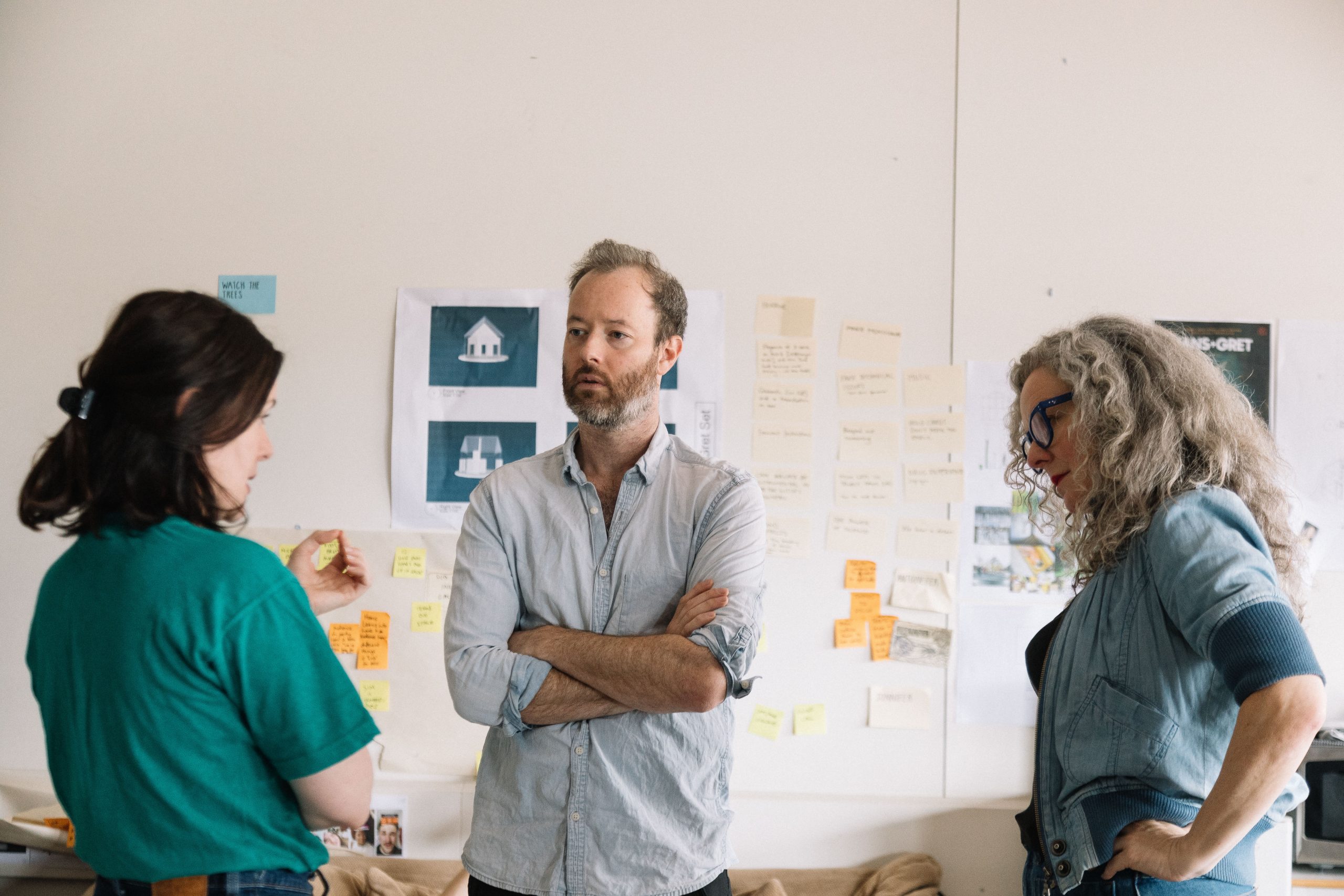
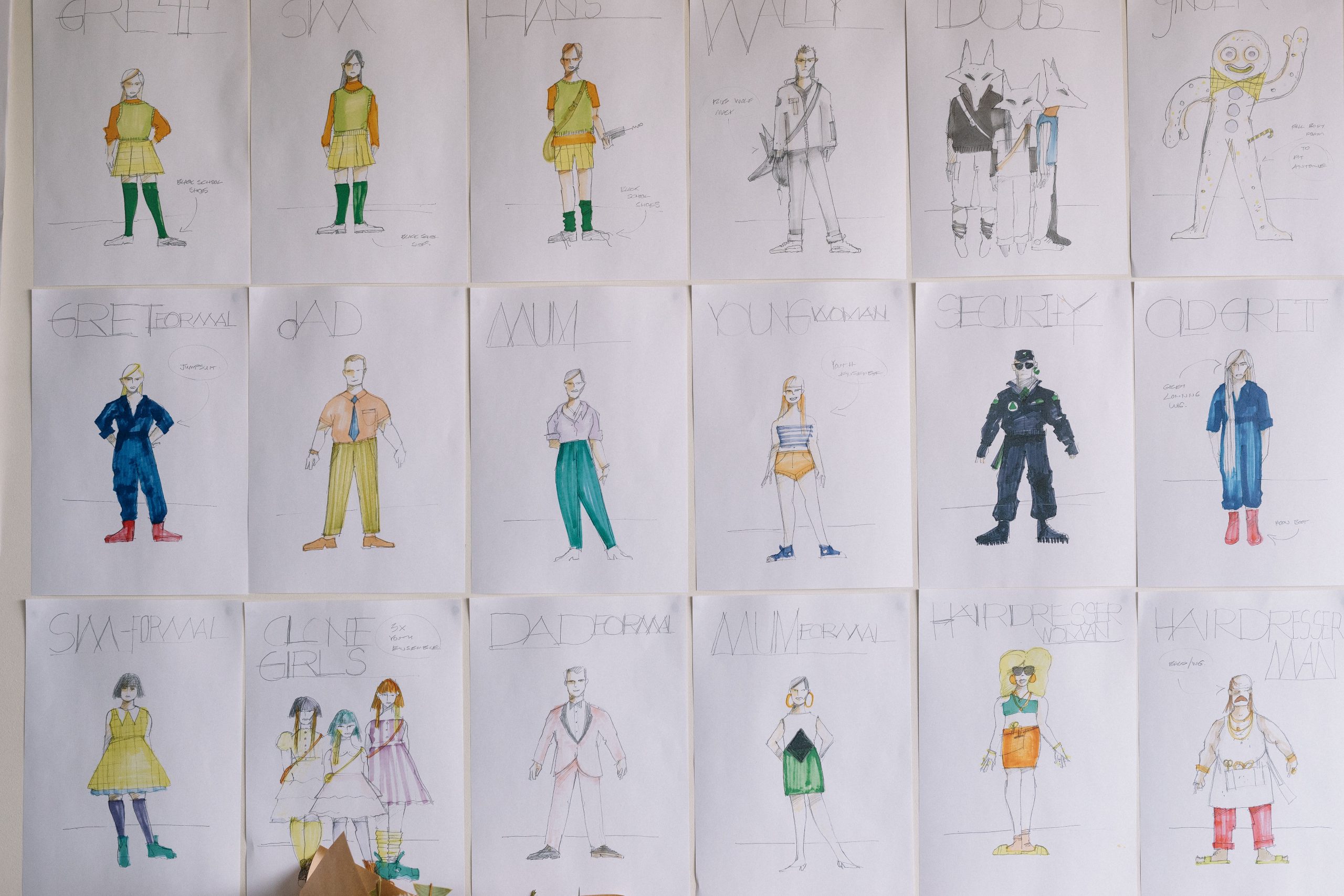
Coming of Age
There are two versions of ‘Coming of Age’ explored in Hans and Gret, that of the young people and that of the middle aged. Gret is desperate to assert herself beyond the boundaries of her family and experience the outside world. These boundaries are metaphorical and concrete, as they live in a gated community. She is growing up and finding her own identity, which is at odds with parental and community expectations. She desires the freedoms that come with being older and begins to experience ‘rights of passage’ into adolescence/young adulthood, such as first love, sex, her formal, parties and drugs. Hans is also seeking freedom by developing and using technology to explore the world outside the gates. Then we have Dad, and particularly Mum, who are ill at ease with themselves and their inevitable ‘coming of older age’ and observe the youthful advantages that their children hold – vitality, potential, beauty, individualism. They want the freedoms that come with being younger. There is also a disruption to the regular hierarchy between the generations in Hans and Gret, where old people become young, young people become old and the balance is lost.
The Family Home
The symbol of the home in Hans and Gret is strong, as it is in the original story. Generally, the family home is a symbol of love, safety and stability. In the original story the home lacks these things and instead is a place of poverty and starvation, housing an unkind mother figure and a weak father. The characters are simple. Hans and Gret goes deeper with the characters and the challenges they face, and as a result the family home is more complex. It is gated, with strict rules to keep them all safe from threats from the outside, giving them a false sense of security, but to some it feels like a jail. The family home morphs to become the nightmarish and cannibalistic gingerbread house and a cage, a lair. It is an ever-changing space, a place of uncertainty and eventually becomes a place of horror.
Manipulation
Hans and Gret live in a dystopian world where manipulation is used as a method of control ensuring that people don’t step outside of the gated community or break the codes of behaviour. These codes of behaviour are supposed to instil trust in the community, and contribute to a sense of safety. The characters must conform and are coerced into doing so by knowing that they are being spied upon, all the while being convinced it is for their own good. Mum wants to conform to the point of losing herself. Gret wants to break rules in order to find herself. Gret is a rebel, who wants to make personal choices – to stand out, to explore, to experience the world outside of the gates.
Truth
Throughout the show, truth is manipulated in different ways. Often mediated by technology and the witch’s powers. This happens both in terms of the narrative being expressed and also for the audience, with the very nature of the reality being depicted onstage being slippery and multiple. In the modern age, we’re constantly fed half-truths, non-truths, and things we really want to believe are true on a daily basis. Hans and Gret asks us to consider why this is, how this happens and what effect this has on us as individuals and as a community.
Elevated Horror
On Adapting Hans and Gret for the Modern Age
On the day we head to Windmill Theatre Company’s office, there is a horror movie being shot in their building. The halls are pulsing with bloody red lights. Our chats about their new show are punctuated by screams and wails and the frantic echo of footsteps as they bounce off the walls around us.
“They’re really going for it out there… that’s so fitting because we’re doing the same thing in the rehearsal room,” laughs Windmill’s incoming Artistic Director Clare Watson after a scream comes from the shoot. She’s in Adelaide to direct Hans and Gret, a new work which takes the traditional Hansel and Gretel fairy tale and transforms it into anarchic psychological thriller. The work, co-produced with experience design studio Sandpit, is set to spook teenage audiences when it premieres at the 2023 Adelaide Festival.
“Horror,” says Watson, “is difficult. Because what it relies on is the audience’s imagination, actually. It’s like… you’re really asking the audience to do most of the work because it’s about accessing their deepest fears.”
She points to a crack in the ceiling, “The trick with that onstage is doing less. You see that crack. I could, if I wanted to, make that terrifying with my imagination. I wouldn’t have to do a lot. It could be a sound or a flash of something… it’s about restraint.”
Based on an original concept by director Rosemary Myers, Hans and Gret is breathless take on the classic that sees two teenagers come of age in a world that has miraculously reversed the ageing process and unpacks the horror at the core of the work.
“I think the original story is full of terror. The idea of bringing horror to the story is not something we’re placing on it,” says Watson, “Horror sits deeply and fundamentally underneath this story. Even in advance of the Grimm fairy tale in the 1300’s. The idea of famine and the truth of children being ejected from the home and left to die in the woods is scary. It’s all wonderfully terrifying.”
Key to the success of the adaptation has been embracing the originality of award-winning writer Lally Katz, who is returning to the Australian stage with the work.
“Lally’s ability to create a the familiar/unfamiliar and give us this sense of the uncanny is remarkable. There’s something about her work that, to me, that presents a story and the truth of character intention and it’s often hilarious… but at the same time you can come away from it and have that unsettled feeling. It’s like when you’ve had one of those morning nightmares that wakes you up and then the whole day you can’t quite shake it? It’s like just below the surface of your reality.
“Lally’s work shows us that the film between what’s really familiar and what’s really scary, or a nightmare is really thin,” she says, “It’s so much fun. I feel like that’s how her work functions best.”
Getting under the audience’s skin is very much a literal part of the work. Sam Haren and the team from Sandpit have designed a sound system using SHOKZ bone conduction headphones that will deliver personalised missives from the tale’s infamous villain directly into your skull.
“The experience we’re creating is that every audience member when they come and see the show wears a pair of bone conduction headphones, which don’t cover the ear but sit just in front of it,” says Haren, “The way that these headphones send sound to you is that they’re vibrating through the bones in your skull and in the bones in your inner ear.
“They’re mainly used for cycling and swimming because they allow you to hear the world around you in addition to the audio they’re transmitting. But we’re using them to deliver this personalised layer of audio for the show in addition to the space as you would normally in a theatre show. It feels quite exciting given that all of this is connected to this witch character who is trying to seduce and control us. It feels very close. Too close.”
In addition to the use of the headphones, each audience member will receive a smartphone device that will additionally mediate and augment the truth of what is being presented onstage.
“In a way what we’re doing with the technology is interrogating one of the cultural rifts that we’re – especially young people – currently dealing with; that technology can be very effective in creating delineated versions of the world that may, in no way be true, but because it’s filtered to us in such a personalised way, we accept it as such.
“Dramatically, we’re finding there’s really exciting things there where the witch can be speaking to everyone at once, but also speaking to individual audience members at different points in the show.”
Hans and Gret, then, presents audiences with a challenge to rethink what their time in the theatre could be, placing them at close quarters with the horror at the centre of the story.
“The function of the witch in any fairy tale is put people under a spell. To manipulate. We’re thinking about ways we can use this technology to cast a spell and shift the audience experience to the whim of the witch,” says Watson.
“There’s a lot of fun to be had in upending that world and in the realisation that the idea of storytelling itself is really slippery. That a narrator can be unreliable.
“When you come to the theatre and you sit in your seat, you’re getting a very individual experience. Because you’re seeing it on a particular night which is different to another night and you sit in a seat that’s different to another seat,” she says, “And what we’re doing with the technology is amplifying that experience. You’re getting that collective communal experience of theatre, and you’ll have the very intimate experience of someone speaking directly in your ear.”
Suddenly there’s another scream from the shoot just down the hall. We both jump out of our seats a bit and Clare laughs, “It’s going to be a real rollercoaster ride… we might even get a few screams for the audience.”
Let's learn
This unit includes activities and possible assessment tasks linked to The Arts: Drama, Australian Curriculum 9.0 across Year 9 and 10. Teachers can choose to use individual activities to complement existing drama units or complete the entire unit of work with their students. In some cases, there is a purposeful link between before and after show activities so that concepts can be built upon.
The learning activities will encourage students to explore Hans and Gret as a performance text, with the possibility of generating whole class discussions and the sharing of different interpretations of the play and the characters, as well as provide opportunities for students to work independently and in small groups to respond to the work creatively.
Many of the activities require a decent translation and adaptation of the Grimm’s version of the story. The Juniper Tree and Other Tales from Grimm translated by Lore Segal and Randall Jarrell is recommended.
By the end of Year 10, students analyse how and why the elements of drama, performance skills and/or conventions are manipulated in drama they create, perform and/or experience. They evaluate how drama in a range of styles and/or from a range of contexts communicates ideas, perspectives and/or meaning. They evaluate how drama is used to celebrate and challenge perspectives of Australian identity.
Students work individually and/or collaboratively to shape and manipulate use of the elements of drama, conventions and/or dramatic structures to communicate ideas, perspectives and/or meaning. They use performance skills relevant to style and/or form to sustain belief, roles and characters in performances of improvised, devised and/or scripted drama for audiences.
Exploring and Responding
Developing Skills and Practices
Creating and Making
Hansel and Gretel Exploration
What you’ll need: Computers, butcher’s paper, markers. “Hansel and Gretel” by the brothers Grimm.
Activity: Read the Grimm’s version of the story, either as a class, in small groups or solo. Brainstorm any themes, motifs, conventions, symbols, archetypes.
In pairs, research how many other versions of the story can be found. Consider stories from other times, places, cultures, modes. Use these findings to create a class list.
In small groups, choose one of the other versions and compare/contrast it to the Grimm’s version, using the original brainstorm as a guide. This can be done as a Venn Diagram, table or online organiser.
Lead a conversation about the similarities and differences between the stories. Consider the following –
This task can be extended into performance (See Task #3).
Content Description Link: AC9ADR10E01
Audience Bias
What you’ll need: “Hansel and Gretel” by the brothers Grimm, computers.
Activity: Make sure students are familiar with the Grimm version of the story.
When we consume culture as audience, we do so with biases and ideas inherited from previous cultural experiences, family, beliefs, origins. The longevity and reach of fairy tales have shaped many of us to identify Witches, Step-Mothers and Wolves as baddies and Fathers, children and cute animals as being the innocents. Is there a way of fleshing these characters out so that they don’t simply sit on one side of the good vs bad continuum? Can we flip them completely so that we can surprise, amuse, inform an audience?
Arrange students into groups of 2 or 3 and assign each group a character from “Hansel and Gretel” – Hansel, Gretel, the Step-Mother, The Father, The Witch, the Duck. Students can brainstorm what they know about the character, as presented in the book. They are searching for facts.
Their task now is to flesh out the character. This is an imaginative task, essentially a re-write of the character. Is there a way of justifying what the Step-Mother did? What about the Witch? Is there a way of concluding that the Father is a baddie? What about the children? How can the duck end up as a malevolent force?
Using this new version of the character, students must come up with responses for the following questions – What does the character want? Why? How are they going to achieve that? What or who is standing in their way? This might be an opportunity to introduce some basic Stanislavski work (super objective, objective, intention, obstacle, method etc.)
Students can use improvisation to write an interview between a television host (eg. Dr Phil style) and the character, with detailed information and insight into this new version of the character, that challenges our preconceived ideas. This will be a re-telling of the story from the first-person perspective.
Once the interview is written, actors can spend some time developing their characters – considering their facial expressions, voice, physicality, gesture, costume.
Students can perform these live or create films of the interviews.
Content Description Link: AC9ADR10D01
Subverted Fairy Tales
What you’ll need: “Hansel and Gretel” by the brothers Grimm.
Activity: This can be a stand-alone task or can be an extension of Task #1.
Reflect on how the creative team transformed characters, settings, themes and events for this production. Consider the use of symbols and metaphor. Make a huge mind map that covers as much detail as possible.
In small groups, students choose or are given a well know Fairy Tale (eg. “Snow White”, “Sleeping Beauty”, “Cinderella”, “Jack and the Beanstalk”, “The Three Little Pigs”, “The Frog Prince”). Do not use “Hansel and Gretel”.
Research the origins of the story and collate a collection of the most interesting moments, focussing on content that does not appear in the more sanitised versions. Draw upon the previous knowledge built in Task #1, focussing on themes, motifs, conventions, symbols and archetypes.
Create a 2-minute performance of this version.
Now take your creation, which will probably by quite dark and brutal, and adapt it for a very young audience. In other words, clean it! Make it something that no parent will ever complain about!
Create a 2-minute performance of this version.
Now it gets even more interesting! Introduce the concept of subversion as “the act or an instance of subverting or overthrowing a legally constituted government, institution, etc” (https://www.collinsdictionary.com/) and rewrite this definition so that it becomes the next task eg. “the act of re-thinking the main elements of Fairy Tales as we know them, to make a comment on a current social, environmental or political issue”.
Make a list of subverted Fairy Tales the students are already aware of (eg. Windmill’s Girl Asleep and Rella, films Tangled and the Shrek Franchise and so on) and discuss what was changed and why? Was it to make it more relevant to a modern audience? Was it to challenge stereotypes or to make a political point?
Groups now need to work out how to subvert their chosen Fairy Tale. What will change? What will remain the same? How can you pursue a modern-day dilemma, using the elements of your Fairy Tale? Possible issues to pursue are – climate change or other environmental concerns, sex and gender discrimination, animal cruelty, racism, poverty vs wealth, political corruption and so on. Encourage students to choose a topic they are passionate about.
Content Description Links: AC9ADR10C01
Who is your audience? Who are you making meaning for?
What you’ll need: Any tech or materials that are on hand, old or new. This might include dividers, blocks, paper, material, microphones, projectors, cameras, screen and so on.
Activity: In the show, the audience was manipulated into experiencing different perspectives of the story, using technology and stage-craft.
As a class, consider the following questions –
Can you think of other shows or versions of storytelling where different audience/s experience different things based on who they are or the choices they make? Eg. video games, censored films, re-interpretations of children’s stories for adults or vice versa, choose-your-own-adventure, interactive film/tv/web experiences and so on.
In groups of 4-6, come up with a situation where it would be logical (not necessarily moral!) to present different information to different people as a type of manipulation. Possible topical ideas could include –
Using live action, film and sound recordings, different spaces, whatever tech is at hand (microphones, headphones, projectors, screens), dividers, sheets, paper and so on, come up with a way of presenting different versions of the ‘story’ to 2 different sections of audience.
Content Description Link: AC9ADR10C01
This unit includes activities and possible assessment tasks linked to English, Australian Curriculum 9.0 across Year 9 and 10. Teachers can choose to use individual activities to complement existing English units or complete the entire unit of work with their students.
The learning activities will encourage students to explore Hans and Gret as a performance text, with the possibility of generating whole class discussions and the sharing of different interpretations of the play and the characters, as well as provide opportunities for students to work independently and in small groups to respond to the work through analysis, adaptation and creation.
Many of the activities require a decent translation and adaptation of the Grimm’s version of the story. The Juniper Tree and Other Tales from Grimm translated by Lore Segal and Randall Jarrell is recommended.
Year 9
By the end of Year 9, students interact with others, and listen to and create spoken and multimodal texts including literary texts. With a range of purposes and for audiences, they discuss and expand on ideas, shaping meaning and providing substantiation. They select and experiment with text structures to organise and develop ideas. They select and experiment with language features including literary devices, and experiment with multimodal features and features of voice.
They read, view and comprehend a range of texts created to inform, influence and/or engage audiences. They analyse representations of people, places, events and concepts, and how texts respond to contexts. They analyse the aesthetic qualities of texts. They analyse the effects of text structures, and language features including literary devices, intertextual references, and multimodal features.
They create written and multimodal texts, including literary texts, for a range of purposes and audiences, expressing and expanding ideas, shaping meaning and providing substantiation. They select and experiment with text structures to organise, develop and link ideas. They select and experiment with language features including literary devices, and experiment with multimodal features.
Year 10
By the end of Year 10, students interact with others, and listen to and create spoken and multimodal texts including literary texts. With a range of purposes and for audiences, they discuss ideas and responses to representations, making connections and providing substantiation. They select and experiment with text structures to organise and develop ideas. They select, vary and experiment with language features including rhetorical and literary devices, and experiment with multimodal features and features of voice.
They read, view and comprehend a range of texts created to inform, influence and engage audiences. They analyse and evaluate representations of people, places, events and concepts, and how interpretations of these may be influenced by readers and viewers. They analyse the effects of text structures, and language features including literary devices, intertextual connections, and multimodal features, and their contribution to the aesthetic qualities of texts.
They create written and multimodal texts, including literary texts, for a range of purposes and audiences, expressing ideas and representations, making connections and providing substantiation. They select and experiment with text structures to organise, develop and link ideas and representations. They select, vary and experiment with language features including literary devices, and experiment with multimodal features.
Year 9:
Literature
– Examining literature
Analyse the effect of text structures, language features and literary devices such as extended metaphor, metonymy, allegory, symbolism and intertextual references (AC9E9LE05)
– Creating Literature
Create and edit literary texts, that may be a hybrid, that experiment with text structures, language features and literary devices for purposes and audiences (AC9E9LE06)
Literacy
– Analysing, interpreting and evaluating
Use comprehension strategies such as visualising, predicting, connecting, summarising, monitoring, questioning and inferring to compare and contrast ideas and opinions in and between texts(AC9E9LY05)
– Creating texts
Plan, create, edit and publish written and multimodal texts, organising, expanding and developing ideas, and selecting text structures, language features, literary devices and multimodal features for purposes and audiences in ways that may be imaginative, reflective, informative, persuasive, analytical and/or critical (AC9E9LY06)
Year 10:
Literature
– Examining literature
Analyse how text structure, language features, literary devices and intertextual connections shape interpretations of texts (AC9E10LE05)
– Creating literature
Create and edit literary texts with a sustained “voice”, selecting and adapting text structures, literary devices, and language, auditory and visual features for purposes and audiences (AC9E10LE08)
Literacy
– Analysing, interpreting and evaluating
Integrate comprehension strategies such as visualising, predicting, connecting, summarising, monitoring, questioning and inferring to analyse and interpret complex and abstract ideas(AC9E10LY05)
– Creating texts
Plan, create, edit and publish written and multimodal texts, organising, expanding and developing ideas through experimenting with text structures, language features, literary devices and multimodal features for specific purposes and audiences in ways that may be imaginative, reflective, informative, persuasive, analytical and/or critical (AC9E10LY06).
Who, What, Why, When?
What you’ll need: “Hansel and Gretel” by the brothers Grimm.
Activity: Read the story to the class, as a class or individually.
Using research and guidance from teacher, answer the questions –
As a class, work through the basic structure of the story and mark out the episodes. Create a narrative arc on the board and mark out the main points (exposition, rising action, climax, falling action, resolution).
In pairs or small groups, make a list of characters and determine for each –
The groups now investigate the ‘copy’ and the photo from the Adelaide Festival Program. Hans and Gret is a modern re-telling of the story. What clues does the information in the program give you? On a planning document or butcher’s paper, groups can come up with what they imagine the changes might be. What is the new story?
Use the list of characters and elaborations, create a new list, based on the information students can glean from the program (eg. in the original story “Hansel and Gretel” are young children, but they are teenagers in the production). They will need to use their imaginations to fill in the gaps.
Write a summary of the new story, highlighting the important plot points. Mark this out on a narrative arc, using the original one to guide you. Use the evidence found in the program and create new, imagined information to complete the story!
This task could end here, or the new narrative could be co-written in pairs, groups or written individually.
Content Description Links:
Year 9: AC9E9LY05, AC9E9LE06
Year 10: AC9E10LY05, AC9E10LE08
Symbolism in “Hansel and Gretel”
What you’ll need: Access to different versions of the story including the brothers Grimm version.
Activity: Lead a general discussion about the use of symbols in society and how they create, distil and augment meaning. List as many symbols as you can and include what they stand for. Consider symbols in literature, film, TV, games, music, person to person communication (verbal and non-verbal), religion, different cultures and so on.
Group the responses under the following and then try to add more to make the list as comprehensive as possible.
Brainstorm symbols from one or more versions of “Hansel and Gretel” and discuss what they stand for in the story. Do any of the symbols have multiple meanings? Are they visual symbols? Verbal symbols? Use the internet to do further research on these symbols, especially in the context of fairy tales.
In groups of 3, choose 1 symbol and place it in the middle of a page. Invent 6 ideas for a short film (no dialogue) using this symbol as a starting point. It must retain its symbolic nature in your film. The film must also contain transformation or change. Flesh out the strongest idea and write a summary of the action. The film must be written with the knowledge that you only have 1-3 actors. The teacher can choose whether to guide the students to create a typical linear narrative or a montage style film.
The following process can be followed –
Content Description Links:
Year 9: AC9E9LE05, AC9E9LE06
Year 10: AC9E10LE05, AC9E10LE08
Back to the Future
What you’ll need: “Hansel and Gretel” by the brothers Grimm.
Activity: Students choose a character from the production who also features in the original story. Compare these two versions of the character, using a Venn Diagram or some other form of graphic organiser.
Consider –
Write a letter from the Hans and Gret version of the character to the one from the Grimm’s story, like the two characters exist in a parallel universe, or the letter is travelling through time somehow. Then you can also write the response.
The letters need to predominantly follow the rules of a narrative recount, expressing an experience of the world at that time and the incidents that occur during the story, using –
You will have to decide why the characters are writing. Is it a warning? Is it like meeting a long lost relative? Is there room for humour or horror or sass? Be imaginative!
Use your comparisons to help you to capture the voice and tone of the two different characters, by considering the differences in –
Extension/modification: This could be performed or recorded as audio/video, with students acting the roles.
Content Description Links:
Year 9: AC9E9LE05, AC9E9LE06
Year 10: AC9E10LE05, AC9E10LE08
Advertisement using the 5 senses.
What you’ll need: Computers, possibly video camera, projectors, sound recording equipment.
Activity: Hans and Gret is an extremely visceral experience with lots of references and action involving taste, sight, sound, smell and touch. Some of these are explicit (eg. cannibalism, ginger bread) and others are inferred (eg. the smell of the world outside the gates). As a class, use the 5 senses to categorise these explicit and inferred moments in the show where the senses were provoked, from the perspective of the audience and the characters.
Drawing upon this information, students create a series of advertisements (or just one) for the show, using the 5 senses to guide them. Consider how the concepts of taste, sight, sound, touch and smell can be used to draw an audience in.
The advertisement could take various forms, such as –
Ensure the use of –
Content Description Links:
Year 9: AC9E9LY06
Year 10: AC9E10LY06
This unit includes activities and assessment linked to the South Australian Certificate of Education (SACE) Stage 1 and 2 Drama across Years 11 and 12. Teachers can choose to use individual learning experiences to complement existing drama units or complete the entire unit of work with their students.
The learning activities will encourage students to explore Hans and Gret as a performance text, with the possibility of generating whole class discussions and the sharing of different interpretations of the play and the characters, as well as provide opportunities for students to work independently and in small groups to respond to the work, creatively.
Many of the activities require a decent translation and adaptation of the Grimm’s version of the story. The Juniper Tree and Other Tales from Grimm translated by Lore Segal and Randall Jarrell is recommended.
Stage 1
The learning requirements summarise the knowledge, skills, and understanding that students are expected to develop and demonstrate through their learning in Stage 1 Drama.
Stage 2
The learning requirements summarise the knowledge, skills, and understanding that students are expected to develop and demonstrate through their learning in Stage 2 Drama.
In this subject, students are expected to:
Understanding and Exploration
Stage 1
UEI – Understanding and exploration of dramatic roles, conventions, and processes.
UE2 – Understanding and exploration of dramatic ideas, texts, styles, and/or innovations.
Knowledge and Understanding
Stage 2
KU1 – Exploration and understanding of dramatic theories, texts, styles, conventions, roles, and processes
KU2 – Understanding and evaluation of the artistic and cultural value of local, global, contemporary, and/or historical drama.
Critical and Creative Thinking
Stage 1 & 2
CCT1 – Creative thinking and experimentation in the development of dramatic ideas (Stage 1 & 2)
CCT2 – Analysis and evaluation of dramatic ideas, products, and technologies (Stage 1 only)
Year 12
CCT2 – Analysis and evaluation of the student’s own drama-making and others’ dramatic works, styles, and/or events (Stage 2 only)
Creative Application
Stage 1
CA1 – Application of dramatic skills.
CA2 – Collaborative application of dramatic ideas and processes to realise outcomes.
Stage 2
CA1 – Application of dramatic processes, individually and in collaboration with others.
CA2 – Application of dramatic skills.
CA3 – Integration of theory and practice to make meaningful dramatic outcomes.
The Perfect Family
What you’ll need: Computers, prior knowledge of the story.
Activity: We will ignore the ‘Happily Ever After’ trope for the time-being and admit that ultimately “Hansel and Gretel’ is about abandonment and violence. There is a dysfunctional family unit consisting of a mother (later changed to a step-mother by the Grimm brothers) who is willing to abandon her children, a father who weakly goes along with it, even though he disagrees, and two innocent children who are betrayed by both parents.
How does this apply to modern day families? Make a list of fictional or celebrity families who have a level of dysfunction. What makes them dysfunctional?
Now make a list of fictional or celebrity families who are ’perfect’. Instagram is a great source for research here. What makes them perfect? Is this level of perfection possible in reality? Why? Why not?
Think about the difference between the public ‘face’ of a family and the private one.
The production of Hans and Gret, deals very much with the pressure on the family to conform, to keep up appearances, to follow the rules. But as with most families – they must deal with differences in perception, perspective and personalities. They are also dealing with the teenagers ‘coming of age’ and the ‘coming of middle-age’ experience of the parents.
Group students into groups of 4-6 and ask them to search up images of ‘The Perfect Family’, considering the concept of the cheesy family portrait. How does this family want the rest of the world to see them?
Create a frozen family photo of the ‘perfect’ family. The family can include a grandparent/s or a pet. Think about the use of levels and shape to create a well-balanced tableau. Smile!
Once that ‘photo’ is created brainstorm who these characters are. What are their relationships to one another? What are the problems the family have that they don’t want the rest of the world to see?
Pretend that the photographer has accidently left their camera on and it is in time-lapse mode. The family do not know this! Create another 5 photos, showing what happens once the charade of capturing the ‘perfect’ shot is over. Each photo must flow to the next, with the group finding synchronised moments to move and freeze as they hit each tableau. Guide students to take their timing from those in front and to use peripheral vision. Make sure you end with a compelling image. Is one person left, crying? Is there knocked over furniture? Are we left with Grandma sitting romantically on Dad’s lap?!
Hans and Gret also includes contrasting elements to highlight darker moments. This can be applied here by choosing some light music or a recording of a happy family story to play while these movement sequences are performed.
Extension:
Assessment Design Criteria Links:
Stage 1: UEI, UE2
Stage 2: KU1
Archetypes in the horrifying world of fairy tales.
What you’ll need: Computers, butcher’s paper, tech – lights/sound equipment, costumes if possible.
Activity: What is an Archetype? Create a class definition and consider archetypal characters, stories and events. What purpose does the inclusion of Archetypes in stories serve?
Research the 7 classic story archetypes and decide which one applies best to “Hansel and Gretel”.
Make a list of the common archetypal characters found in stories, particularly fairy tales. Decide which archetype fits with the characters in the story and co-create a graffiti wall for each (Hansel, Gretel, Step-mum, Dad, Witch). This could include defining features, images, definitions & examples from literature, film, TV & games.
Divide the class into groups and ask them to create 2 scenes, ensuring that each character (apart from the duck!) is featured. They must focus on the archetypal information from the graffiti wall and to exaggerate these details. Be a more monstrous monster, or a ridiculously innocent child!
Show each other the short scenes and discuss what was seen. How did the students use their bodies, voices and facial expressions to show this archetype? Ask students to respond by analysing what this style of characterisation did for them as audience members. Was the interpretation clear? Familiar? What did the students learn? Did the performance sit in the children’s theatre genre or the horror genre or somewhere in between? Remember that original fairy tales were often terrifying and not children’s stories!
Students now form a small company with a variety of roles such as actors, director, designers (lighting/costumes/set/sound & music) & stage manager. These roles can be doubled up.
Students must agree on which story archetype to follow and explore the characters even further. Can they apply more than one archetype to their character? Do the characters go through any changes? An example would be Hansel the hero who needs rescuing in the end, or Gretel the innocent who ends up murdering the witch. For the step-mother and Witch, the changes can be inferred or invented, as they are not as obvious.
Some elements of horror are implicit in the story but do need to be highlighted, such as character types, setting, themes. Students must also include these elements –
Students perform for one another and provide verbal and/or written feedback regarding their use of the elements of horror, performance skills, characterisation using exaggerated archetypes, and the way these choices created meaning for the audience.
Assessment Design Criteria Links:
Stage 1: CA1, CA2
Stage 2: CA1, CA2
Who are the modern-day Witches?
What you’ll need: Computers, butcher’s paper, possible access to production elements.
Activity: In Hans and Gret, there is a moment when Jennifer implies that she is the an ‘every-witch’, implying that she embodies every ‘witch’ that ever was. She also reminds us of the gendered and misogynistic history of witches, and how those tropes still exist today. The Witch is the supposed unnatural woman; and in fiction she is the monster who unleashes malevolence.
In the case of Hans and Gret, Jennifer IS a malevolent monster. She is not someone falsely accused. She is a manipulator and a murderer.
Are there modern-day malevolent monsters? People who manipulate, control and abuse? Perhaps the witch represents a collective of people or a corporation? (eg. Hitler, multi-nationals etc.)
Are there modern-day witches who are falsely accused, much like those in Medieval Europe, demonised by the society or the media? (eg. asylum seekers, step-parents etc.)
Create a list of perceived monsters VS real monsters.
Are there modern-day abandoned children? A group of people who are left to fend for themselves in difficult circumstances? Or who are ignored? Encourage the students not to be literal. (eg. Uyghur people, people in extreme poverty etc.)
Create a piece of political theatre focussing on a real event, loosely based on the episodic structure of “Hansel and Gretel”, where the ‘Witch’ is replaced by a modern-day monster and the children are replaced by the modern-day abandoned children/people. How does this play out? Do the ‘children’ overcome the ‘monster’ as they do in the story? Or is the ending unhappy?
Boal’s Forum Theatre would work well here, where the ‘most likely’ outcome is played out as the ending. The performance is played out once in entirety and then again. The second and subsequent times, the audience (‘spect-actors’) interrupt the action and change it by joining the scene, playing one of the roles. Please refer to Boal’s Games for Actors and Non-Actors or other more general drama books such as A Practical Approach to Drama Performance by Louis Tourelle and Marygai McNamara for more on Forum Theatre.
Assessment Design Criteria Links:
Stage 1: CCT1, CCT2
Stage 2: CCT1, CCT2
Staging the impossible.
What you’ll need: A variety of tech – lights, torches, big pieces of paper, cardboard boxes, material, string, mirrors, video camera, projector/s (even overhead or handheld) and so on.
Activity: One of the exciting things about fictional writing is that anything is possible. Sometimes when film and theatre makers adapt an existing text, they must work out ways to stage fantastic action. The use of special effects in film makes this possible. But it is harder in theatre.
Lead a conversation and make notes on all of the ‘fantastical incidents’ that occurred in Hans and Gret and how the artistic team made these ‘impossible’ things happen? Consider the use of light, set design, costume. Consider examples of high tech and lo-fi theatre magic. Consider what this meant to the audience in terms of what it made them think, feel & know.
In small groups, choose an object and character from another fairy tale (The Giant and the beans, The woodcutter and the apple and so on) and use whatever lo-fi and high-fi tech is available and set the following challenges, focussing on these characters/objects –
In groups, students create a short narrative summary using the object, character and their three best magical moments. Students could write a design and/or director’s concept at this point. It could end here or become a ‘company and production task’ where this performance is fleshed out and staged.
Assessment Design Criteria Links:
Stage 1: UE1, UE2
Stage 2: KU1
This unit includes activities and assessment linked to the South Australian Certificate of Education (SACE) Stage 1 and 2 Drama across Years 11 and 12. Teachers can choose to use individual learning experiences to complement existing drama units or complete the entire unit of work with their students.
The learning activities will encourage students to explore Hans and Gret as a performance text, with the possibility of generating whole class discussions and the sharing of different interpretations of the play and the characters, as well as provide opportunities for students to work independently and in small groups to respond to the work, creatively.
Many of the activities require a decent translation and adaptation of the Grimm’s version of the story. The Juniper Tree and Other Tales from Grimm translated by Lore Segal and Randall Jarrell is recommended.
Stage 1
The learning requirements summarise the knowledge, skills, and understanding that students are expected to develop and demonstrate through their learning in Stage 1 English.
In this subject, students are expected to:
Stage 2
The learning requirements summarise the knowledge, skills, and understanding that students are expected to develop and demonstrate through their learning in Stage 2 English.
In this subject, students are expected to:
Knowledge and Understanding
Stage 1 & 2
KU1 – Knowledge and understanding of ideas and perspectives in texts.
KU2 – Knowledge and understanding of ways in which creators of texts use language features, stylistic features, and conventions to make meaning.
KU3 – Knowledge and understanding of ways in which texts are created for different purposes, audiences, and contexts.
Analysis
Stage 1
An1 – Analysis of the relationship between purpose, audience, and context, and how they shape meaning.
An2 – Analysis of how language features, stylistic features, and conventions are interpreted by readers.
An3 – Analysis of intertextual connections.
Stage 2
An1 – Analysis of ideas, perspectives, and/or aspects of culture represented in texts.
An2 – Analysis of language features, stylistic features, and conventions, and evaluation of how they influence audiences.
An3 – Analysis of similarities and differences when comparing texts.
Application
Stage 1
Ap1 – Precision, fluency, and coherence of writing and speaking.
Ap2 – Use of appropriate language features, stylistic features, and conventions for a range of audiences and purposes.
Ap3 – Use of evidence from texts to support conclusions, with textual references incorporated in responses.
Stage 2
Ap1 – Use of language and stylistic features to create texts that address the purpose, audience, and context.
Ap2 – Use of evidence from texts to develop and support a response.
Ap3 – Use of clear, accurate, and fluent expression.
Making meaning for who?
What you’ll need: A translation of the Grimm brother’s version of the story, paper/stationary & computers, access to media about the production.
Activity:
Reading the story
Read the story and have a discussion using the following key questions –
Annotating the story
Work through the story and annotate the following –
Annotate and elaborate on the following, using research.
Answer the question –
Why are these devices always present in fairy tales and myths?
Rhetorical Triangle
Present students with a rhetorical triangle pro-forma with blank spaces to fill in or ask the students to draw one on big pieces of butcher’s paper, in pairs or small groups. The usual headings on a rhetorical triangle are –
Rhetorical Triangle part 2
Turn the attention of the students towards the production of Hans and Gret, written by Lally Katz, in collaboration with actors and designers, which they will soon see! How can this rhetorical triangle be applied to a live performance? Source information about the show – newspaper articles, Adelaide Festival program blurb and interviews with key creatives embedded into the Windmill Education Resources (See above). Students do the same rhetorical triangle task with what they can glean from the resources they have at hand.
After seeing the show, this can be revisited.
Assessment Design Criteria Links:
Stage 1 & 2: KU2, KU3
The Grimm’s and Dortchen Wild
What you’ll need: My Fairy Tale Fascination – Kate Forsyth
Activity:
It is quite well known that the Grimm brothers did not invent “Hansel and Gretel”, or any other fairy tale. They adapted them, writing down tales that were carried through various cultures and countries aurally.
Read the article My Fairy Tale Fascination – Kate Forsyth
Introduce the concept of Feminist Theory with the students, exploring concepts such as –
In pairs, apply these ideas to “Hansel and Gretel”.
Students share their findings with another group or with the whole class. Listen for any debatable points. Use this analysis and research to create a few topics for debate, such as –
Students form teams and a debating tournament can be staged.
Assessment Design Criteria Links:
Stage 1: An1, An2
Stage 2: An1, An2
Freaky Friday.
What you’ll need: Computers, freaky Friday clips, perhaps the book Freaky Friday.
Activity: After seeing the play, consider the characters of Mum and Gret. Briefly discuss the evolution of these characters from the Grimm version. What changes have been made? Make a class list. Discuss WHY the creative team and Lally Katz made these changes. You can also reference different mother/daughter relationships in stories such as Snow White and Cinderella. Do these stories raise similar issues?
Mum and Gret are both experiencing a type of ‘coming of age’ but manage these changes in completely different ways.
Use the following words and apply them to Mum and Gret using a Venn Diagram or some other kind of information organiser –
Ask students if they know of the book or film Freaky Friday. Discuss this concept and allow them to read the synopsis of the book (Freaky Friday by Mary Rodgers) or watch a trailer of the film (1976, 1995 and 2003 versions). This is an extreme, comedic take on adults and children coveting the life of the other.
Students consider the tense moments between Mum and Gret in the show (prom dress, hair-cuts, drugs, surveillance, freedom of movement) and come up with their own scenario where tension may arise between a parental figure and a child. The class can brainstorm a list here.
Students now write their own episodic narrative using the following conventions –
Consider the following techniques –
The typical ‘choose your own adventure’ structure is complex and time consuming. Instead, students can begin a story in third person and at a certain point, pursue the perspective of the child in first person. Once the story has come to its conclusion, students can come up with a way to take the reader back to the point where it changed from third person to first person, but this time, the story can be told from the perspective of the adult. It will probably end differently.
Assessment Design Criteria Links:
Stage 1: An3, Ap2
Stage 2: An3, Ap1
Greatest Fear Newspaper article
What you’ll need: A range of feature articles – online or hardcopy, computers, brainstorming gear (paper, whiteboard or digital templates)
Activity: Brainstorm the themes, tropes, archetypes and structures that are found in the original story of “Hansel and Gretel” (eg. children facing adversity, the wicked step-mother, a witch, wolves, the house). Now do the same with the production of Hans and Gret. Are there any cross-overs?
Consider the question – What ‘greatest fears’ are represented in both versions? Eg. Abandonment, starvation, loss of civil liberties etc. Some of these might be contextual (historical or geographical) to the time the story was written or adapted, and some may be timeless or belong to the present. Make a list.
Choose one of the ‘greatest fears’ from Hans and Gret (which (may also be present in the original story) and write a feature article about it, as though it is real life. Set the article in the world of the play, using the characters and some key moments.
Give students a range of feature articles to analyse, perhaps annotating them to comprehend the necessary features and the intention of the author. These articles will be non-fiction, while theirs will be fiction, but the same rules apply.
Consider –
Remember to write in a persuasive tone, to encourage readers to continue reading and appeal to their emotions.
Assessment Design Criteria Links:
Stage 1: KU3, An1, An3, Ap2
Stage 2: KU3, An1, An3, Ap1
Produced by Windmill Theatre Company. Developed and compiled by Drama Education Specialist Astrid Pill and Windmill Theatre Company.
The activities and resources contained in this document are designed for educators as the starting point for developing more comprehensive lessons for this work.
© Copyright protects this Education Resource. Except for purposes permitted by the Copyright Act, reproduction by whatever means is prohibited. However, limited photocopying for classroom use only is permitted by educational institutions.
This resource is proudly supported by the South Australian Department for Education and the Lang Foundation.
Interested in presenting? Click here
Responsive, lightweight, fast, synchronized with CSS animations, fully customizable modal window plugin with declarative configuration and hash tracking.